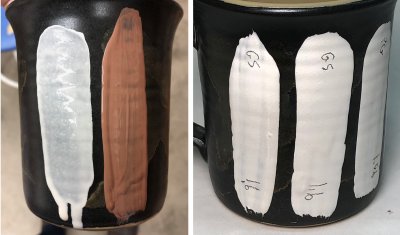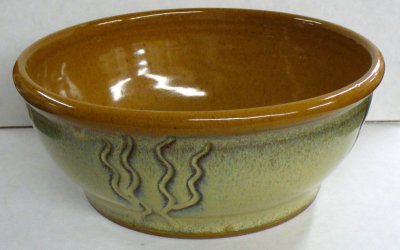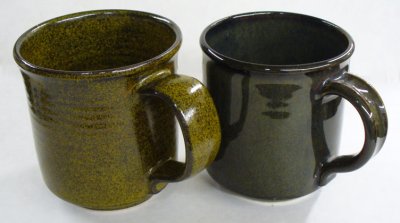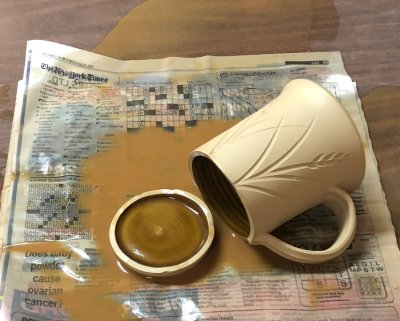 Vancouver Island Pottery Supply
Vancouver Island Pottery Supply

Normal Hours of Operation Closed all provincial and federal holidays Next closure for a Stat holiday is for AUGUST 5TH BRITISH COLUMBIA DAY
Information Plainsman Products ClaysLow Temperature ClaysMedium Temperature Clays High Temperature Clays Porcelains Other Clays Native Clays Casting Slips MaterialsDry MaterialsStains Encapsulated Stains Liquids GlazesSpectrum Low Stone GlazesLaguna Dry Low Fire Glazes Duncan Low Fire Clear Glazes Spectrum Opaque Gloss Low Fire Glazes Spectrum Semi-Transparent Low Fire Glazes Spectrum Satin Matte Low Fire Glazes Spectrum Crackle Glazes Spectrum Metallic Glazes Spectrum Raku Glazes Plainsman Dry Glazes Potter's Choice Cone 5/6 Glazes Celadon Cone 5/6 Glazes Moroccan Sand Glazes Spectrum Hi Fire Cone 6 Glazes Spectrum Shino Glazes Cone 6 Spectrum Celadon Glazes Cone 6 Liquid Brights UnderglazesSpectrum 500 UnderglazesCrysanthos Underglazes Spectrum RAC Underglaze Pens Underglaze Tools Amaco Velvet Underglazes EnamellingEnamelling SuppliesEnamelling Tools EquipmentKilnsElectric Pottery KilnsElectric Glass Kilns Kiln Furniture Cones Elements Kiln Parts, Accessories Exhaust Systems Refractories Potter's Wheels Slab Rollers Hand Extruders Pugmills Scales Banding Wheels Air Brushes ToolsBrushesThrowing Tools Trimming, Turning, Cutting Tools Wood/Bamboo Tools Wire and Wood Tools Rollers/Stamps Decorating Tools Glazing Tools Ribs & Scrapers Ribbon/Wire Tools Rasps Knives, Needle Tools, Cutters Sculpture Tools Tool Kits Unclassified AccessoriesMiscellaneous AccesoriesCorks/Stoppers Cork Pads Dispenser Pumps Teapot Handles Bisque Tiles Magazines | Covid-19 Status: Click here to find out more
CLOSED AUGUST 5TH,2024 BRITISH COLUMBIA DAY OPEN MONDAY -FRIDAY 9:00 - 4:00
Vancouver Island Pottery Supply has a large supply of pottery materials. Equipment...wheels, kilns, slabrollers. Clay, dry materials, great selection of tools. Product can be put together for pick up, or shipping is available. Prices are subject to change without notice
We strive to give our customers great customer service, while shopping in the store or by phone. Our staff knows our product and equipment, and can help you with your selections. If you have a larger order to get together please call or email the order in, so we can have your product ready. Email sales@vipotterysupply.com or call 250 248-2314. Technical Tips BlogMosaic mural in Dan McCharles Park - made by Luke Lindoe in 1961
The mural is made from unglazed stained stoneware tiles, each cut to shape. The inscription reads: "THE DOCTOR OF TODAY TAKES HIS PLACE AT THE HEAD OF A VERY LONG LINE OF DISTINGUISHED PREDECESSORS; THE KNOWLEDGE AND TRADITION THAY MAKES THE MEDICAL PROFESSION WHAT IT IS TODAY GROWS FROM Context: Luke Lindoe in 1971, A gas kiln built.., Measuring clay test bars.., Incised iron reduction fired.., Crazed iron reduction fired.., Luke Lindoe at Wikipedia.. Monday 22nd July 2024 CMC Gum does not work well in a glaze if an important ingredient is missing
On the left, the brush-strokes of gummed glaze, which I batched myself, have been freshly painted onto an already-fired glaze. Notice the brown brush stroke holds its character. It has a high specific gravity (SG): 1.6. And contains 1.5% CMC gum. The white one to its left, whose brush stroke has flattened and it is running downward, has the same gum content but an SG of 1.5. Is it running because of its lower SG? No. Commercial glazes with an SG below 1.3 still hold in place well. How? Because they also have a gelling agent (e.g. Veegum - it has an unfortunate name, it is not a gum). That reveals a secret: Gums and gelling agents need each other. CMC Gum needs particle surface area to work its magic and bentonite, the gelling agent here, supplies that. And, the gelling agent needs the gum to slow down drying and enable a hard and crack-free dried surface. The dried strokes on the right demonstrate that - 2% bentonite has been added to the drippy one on the far left. They held in place because of the bentonite and hardened without cracking because of the CMC gum. Context: CMC Gum, Bentonite, Veegum, Brushing Glaze Monday 15th July 2024 Low fire mug survives two-foot drop on to cementIn slow motion. This is Plainsman Snow clay, a super white burning dolomite body. Fired at cone 04. Although low-temperature ware is not as strong as stoneware it has more elasticity. Other than a tiny chip out of the base and handle, this mug still has the ring of strength. Where does this piece get all this strength? 1. It is glazed inside and out. 2. Glazes adhere well to this porous body, forming a deep interface. 3. The compression under which the glazes exist not only resists crazing but adds a lot of strength to the piece. Notice how it bounces onto the handle also! Context: Fired Strength Friday 5th July 2024 Cone 10 Reduction with Alberta and Ravenscrag SlipsOutside is the GR6-A recipe (made using 50:50 roasted and raw Alberta Slip), there are no other additions. The inside is pure Ravenscrag Slip GR10-A (also a 50:50 mix of roast:raw), with no additions. The clay is Plainsman H550. The firing schedule is C10RPL. Friday 5th July 2024 Variegating effect of sprayed-on layer of titanium dioxide
The base glaze (inside and out) is GA6-D Alberta Slip glaze fired at cone 6 on a buff stoneware. However, on the outside the dried-on glaze was over-sprayed with a very thin layer of titanium and water (VeeGum can be used to help gel the sprayable titanium slurry and suspend it). The dramatic effect is a real testament to the variegating power of TiO2. An advantage of this technique is the source: Titanium dioxide. It is a more consistent source of TiO2 than the often-troublesome rutile. Another advantage is that the variegation can be selectively applied in specific areas or as a design. This effect should work on most glossy glazes having adequate melt fluidity. Context: Titanium Dioxide, GA6-D, Reactive Glazes, Crystallization, Glaze Layering, Variegation Thursday 4th July 2024 A mug cracks before your eyes because of glaze compressionThe glaze on this highly vitreous, thin-walled mug is normally perfect, it is under enough thermal compression to really increase ware strength. But, since this mug is glazed inside only, the compression is too great. While it looks OK, the glaze is constantly pressing outward, looking for relief. Watch as a tap with a spoon is enough to trigger a sudden crack. And it opens under the pressure, clearly revealing the piece was spring loaded. This is a simple test. A typical mug of this clay would survive hundreds impacts of this nature. Further, this did not happen just because it was not glazed on the outside. A mug with glaze under compression on the inside and under tension on the outside would fail this test even more dramatically. Context: Is inside-only glazing a.., Glaze Compression Monday 1st July 2024 The same glaze fires very differently depending on kiln cooling rate
Both mugs use the same cone 6 oxidation high-iron (9%), high-boron, fluid melt glaze. Iron silicate crystals have completely invaded the surface of the one on the left, turning the gloss surface into a yellowy matte. Why? Multiple factors. This glaze does not contain enough iron to guarantee crystallization on cooling. When cooled quickly it fires the ultragloss near-black on the right. As cooling is slowed at some point the iron will begin to precipitate as small scattered golden crystals (sometimes called Teadust or Sparkles). As cooling slows further the number and size of these increases. Their maximum saturation is achieved on the discovery, usually by accident, of the likely narrow temperature range they form at (normally hundreds of degrees below the firing cone). Potters seek this type of glaze but industry avoids it because of difficulties with consistency. Context: B2O3, Fe2O3, Ravenscrag floating blue color.., The matteness of this.., Alberta Slip GA6-A glaze.., Cooling rate drastically affects.., Same glaze fires hyper-matte.., The appearance of this.., Melt Fluidity, Glaze Chemistry, Crystallization Monday 1st July 2024 Is inside-only glazing a good idea? We say it is not.
This mug is made from 325 mesh MNP, the strongest porcelain I have. Since the walls are of even thickness with no abrupt corners or contour changes and the glaze is thinly and evenly applied I thought I could follow a social-media-driven trend and glaze only on the inside. But I got glaze compression time-bombs waiting for hot coffee triggering! Three other mugs failed this same way! But four with this same glaze inside and out were fine. Why? The outside glaze counters the inside one pushing outward. And it closes crack initiation points. Context: Drip glazing and bare.., Example of COE curves.., A mug cracks before.., The handle is strong.., Here is how far.., Glaze Compression Thursday 27th June 2024 A down side of high feldspar glazes: Crazing!
This reduction celadon is crazing. Why? High feldspar. Feldspar supplies the oxides K2O and Na2O, they contribute the brilliant gloss and great color but the price is very high thermal expansion. Scores of recipes being traded online are high-feldspar, some more than 50%! There are ways to tolerate the high expansion of KNaO, but the vast majority are crazing on all but high quartz bodies. Crazing is a plague for potters. Ware strength suffers dramatically, pieces leak, the glaze can harbor bacteria and customers return pieces. The simplest fix is to transplant the color and opacity mechanism into a better transparent, one that fits your ware (in this glaze, for example, the mechanism is simply an iron addition). Fixing the recipe may also be practical. A 2:1 mix of silica:kaolin has the same Si:Al ratio as most glossy glazes, this glaze could possibly tolerate 10% of that. That would reduce running, improve fit and increase durability. Failing that, the next step is to substitute some of the high-expansion KNaO, the flux, for the low-expansion MgO, that requires doing some glaze chemistry. Context: Feldspar, Na2O, ChatGPT is completely wrong.., Cone 1 mug is.., Celadon Glaze, Calculated Thermal Expansion, Limit Recipe, Glaze Crazing Wednesday 26th June 2024 Preparing clay test bars to measure plastic, dry and fired physical properties
This is being done for SHAB, LOI and DFAC tests. The clay was wedged thoroughly, rolled to 3/8 thickness (using the metal rods as gauges) and then cut to 4 1/4" by 1" bars. Code numbers and specimen numbers are stamped on each (these are needed to enter data into our account at Insight-live). For example, notice that the bars have specimen numbers from 1 to 6. These will be fired at six different temperatures (for a low-temperature body, for example, we fire cone 06, 04, 03, 02, 01, 1, 2). The data measured from each, including the temperature, will be entered for each bar (specimen). The 12cm dia. disk is being cut from 3/16" thickness. Notice how these clay tears as cut, this is an indication of the low plasticity of this native clay material. And notice the greenish color, that is typical of terra cotta clays. Context: Shrinkage/Absorption Test, Code Numbering Saturday 15th June 2024 SignUp For Monthly Tech-Tip EmailPlease visit https://digitalfire.com and use the Register feature at the top of the page. No art or sales language, no tracking and no ads. To find past posts please use the search bar on this page. |
Vancouver Island Pottery Supply, 515 Stanford Avenue E, PARKSVILLE, BC V9P 1V6
Phone: 250-248-2314, FAX: 250-248-2318, Email: sales@vipotterysupply.com